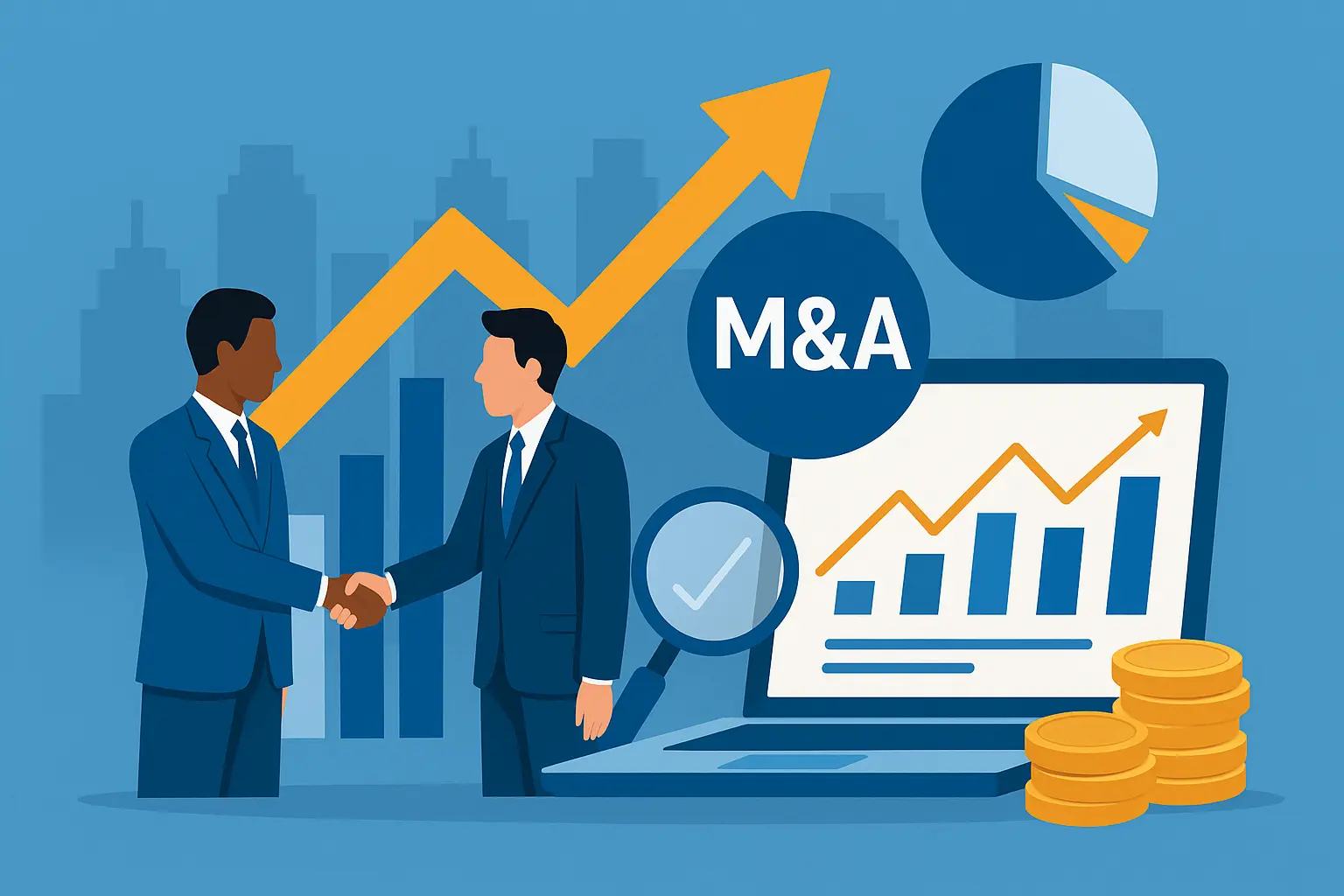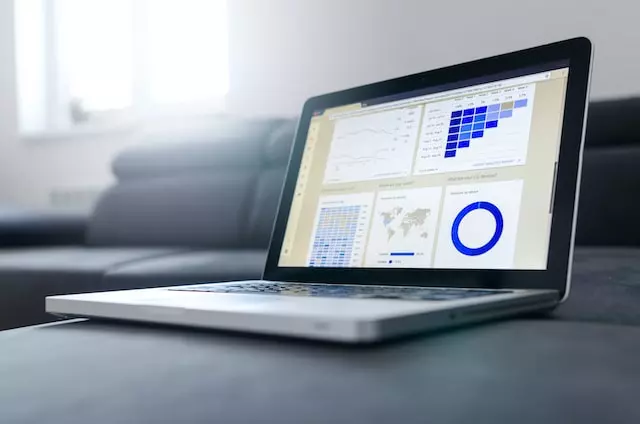Market researchers report that in 2025, M&A deal volumes and values will increase after a post-COVID breakdown. AI disruption, elevated interest rates, and geopolitical tensions drive the expansion in technology, energy, healthcare, and other sectors.
In this overview, we explore recent mergers and acquisitions, mentioning notable deals and significant M&A industry trends that are shaping the market in 2025. This information will be helpful for business executives, investors, and analysts who are monitoring M&A deals to identify growth possibilities.
M&A market overview: 2024–Q1 2025 snapshot
In 2024, the global M&A market saw a 12 % rise (to $3.4 trillion from $3.1 trillion in 2023), slowly but surely approaching the pre-pandemic level. Despite the growing interest rates and geopolitical conflicts, dealmakers grew more active as inflation cooled and central banks cut rates. Private equity and tech, especially AI, drove growth. However, the election uncertainty and unpredictable decisions of the new presidency still leave some questions for 2025.
In late 2024 and early 2025, the number of larger deals grew. In fact, $2 billion+ deals increased by 20% year-over-year. Nine out of ten top M&A deals in 2024 were conducted by corporate acquirers, identifying their growing activity.
M&A market overview: 2024 – Q1 2025 by region
In North America, the deal value increased by 9%, driven by the increase in technology deal value and sponsor-led buyout value. Energy and utility M&A deals rose by 80% in value.
In the Asia-Pacific region, the year-over-year growth was less prominent, seeing a 3% deal value increase. Eight out of the ten latest M&A in the North American region took place in the second half of the year. This hints at the potential for a larger resurgence in 2025.
Europe, the Middle East, and Africa saw an increase of 10% in deal value. In fact, deals that involve financial sponsors rose 36% in value and take-private transactions in Europe surged to a record 95 deals.
M&A market overview: 2024 – Q1 2025 by sector
The technology sector saw a 16% rise in deal activity compared to 2023. In 2024 and the first months of 2025, dealmakers continue to show strong enthusiasm for AI and machine learning technologies. They believe these sectors will present the greatest M&A opportunities.
Watching the recent tech M&A deals, experts noticed that cybersecurity deals even surpassed AI ones, being the top focus for tech dealmakers. This means the risk mitigation is top of mind for those in tech M&A.
Life sciences M&A deal value was down in 2024 from 2023, but healthcare was still the second largest M&A segment, with 10% of global M&A value, after 19% of global M&A value for tech. Big life sciences companies need to fill their pipelines and lower interest rates will help them get bigger deals in 2025.
After a slow 2023, private equity deal activity was up 34% in value in 2024, with tech accounting for 32% of buyout value. Sponsor exit value was up 25% in 2024, with 28 IPOs. The 2024 Tech M&A Survey says sponsor sentiment is high for 2025, with 57% of private equity respondents expecting more deals over the next 12 months.
Most recent M&A deals (January – March 2025)
According to the IMAA institute data, between March 24 and March 30, the global mergers and acquisitions market recorded 630 deals, totaling $41.63 billion. Notably, 14 of these transactions were over $500 million each, reaching $32.15 billion. This represents 77% of the overall deal value.
As the report highlights, the M&A activity in Q1 2025 shows cautious optimism. Deal volumes and values are slightly higher compared to 40 in the same period in 2024. However, the numbers are still lower than in 2021-2022. Below, we highlight some of the most prominent mergers and acquisitions examples from January to March 2025:
| Date | Acquirer | Target | Deal Value | Sector | Key Notes |
|---|---|---|---|---|---|
| Jan 2025 | Johnson & Johnson | Intra-Cellular Therapies | $14.6 billion | Biotech | J&J aims to bolster its portfolio in treatments for central nervous system disorders. |
| Jan 2025 | American Axle & Manufacturing | Dowlais | $1.3 billion | Automotive | This acquisition aims to strengthen both companies amid the transition to electric vehicles. |
| Feb 2025 | Cisco | Splunk | $28 billion | Cybersecurity | Closed after antitrust review. Aimed to boost AI-driven data analytics. |
| March 2025 | Whitecap Resources | Veren Inc. | $15 billion | Energy | Whitecap becomes the 7th-largest Canadian oil producer by output and largest landholder in Alberta’s Montney and Duvernay formations. |
| March 2025 | ServiceNow | Moveworks | $2.85 billion | AI | This acquisition is expected to enhance the AI capabilities of ServiceNow. |
Biggest M&A deals (2024–2025 YTD)
Below, we provide some of the largest and most famous M&A deals by value in 2024-2025 to help investors and deal makers explore how the leading companies navigate the market and how industries reshape and evolve in the rapid global landscape.
| Deal Value (USD) | Acquirer | Target | Industry | Key Details |
|---|---|---|---|---|
| ~$69.7b | Microsoft | Activision Blizzard | Gaming/Tech | Closed in 2023, but the major impact was in 2024. Largest gaming deal ever, reshaping cloud gaming. |
| ~$100b (est.) | ExxonMobil | Chevron | Energy/Oil & Gas | Pending (2025 expected). The biggest oil deal in decades, consolidating shale dominance. |
| ~$28b | Cisco | Splunk | Cybersecurity/Data | Closed in 2024. Major move in AI-driven data analytics and security. |
| ~$53b | Chevron | Hess Corp | Energy/Oil & Gas | Closed in 2024. Strengthens Chevron’s position in offshore/Guyana reserves. |
| ~$64.5 billion | ExxonMobil | Pioneer Natural Resources | Energy/Oil & Gas | Closed in May 2024. This move positions ExxonMobil as a leading operator in the Permian Basin region. |
| ~$35.9 billion | Mars | Kellanova | Food/Beverage | Pending (2025 expected). This acquisition is set to establish Mars’ dominant presence in the global snack market. |
Upcoming M&A deals to watch in 2025
2025 is a promising year for M&A deals, especially across hot sectors like AI, fintech, energy, healthcare, and biotech. Further, we explore the upcoming mergers and acquisition deals that are catching the attention of multiple investors globally.
McLaren’s merge with Forseven
Potential value: not disclosed
Industry: Automotive
McLaren is merging with British EV startup Forseven, backed by Abu Dhabi’s CYVN, to expand beyond supercars into electric vehicles and potentially SUVs. The move gives McLaren access to EV tech (including from CYVN-backed Nio) while helping Forseven leverage McLaren’s luxury brand power.
CPP Investments & GIP acquisition of Allete
Value: $6.2 billion
Industry: Energy
Allete’s acquisition by CPP Investments and Global Infrastructure Partners (GIP) is planned for Q2 2025. This deal highlights the shift in the investment focus on renewable energy and its infrastructure. The success of the deal is high as it is driven by two major investment firms with strong financial positions.
T-Mobile’s acquisition of US Cellular
Value: $4.4 billion
Industry: Telecommunications
Another prominent acquisition that is scheduled for Q2 2025 is T-Mobile’s acquisition of US Cellular’s wireless spectrum. Industry leaders call it a smart move to enhance T-Mobile’s network coverage, specifically for geographically isolated areas in the U.S.
Apple’s acquisition of Rivian (Rumored)
Potential value: unclear
Industry: EV/Automotive
An Apple insider mentioned that Apple may revive its EV car ambitions by acquiring an EV maker like Rivian. This deal with Apple can be life-changing for Rivian. As part of Apple, it would immediately gain access to a larger team of engineers and technologists, plus a part of Apple’s funds. Apple, in turn, would access the EV market and add yet another product to its ecosystem.
These are some major and rumored acquisitions to take place in 2025. For more insights on the upcoming deals, it is worth watching the AI, biotech, pharma, energy, and fintech sectors. The market overview highlights that these are the most active areas this year. In fact, we will explore the sectors in more detail further down.
Sector-specific spotlight
Here are some of the global M&A trends that will shape the M&A landscape in 2025 and beyond.
Tech M&A trends and deals
In the tech space, the AI arms race continues, along with a cybersecurity surge and SaaS roll-ups. Big Tech (such as Microsoft and Nvidia) will continue buying startups for LLMs, chips, and cloud AI to dominate the next computing era. In its turn, cybersecurity deals boom due to rising cyber threats.
On the other hand, regulatory scrutiny is intensifying, as seen when regulators blocked Adobe’s $20 billion Figma acquisition. Private equity firms are also rolling up niche SaaS platforms at a record pace.
Healthcare M&A trends
In 2025, pharma giants will continue spending billions to acquire biotech firms specializing in weight-loss drugs and cancer therapies. Private equity firms are snapping up hospitals and healthcare providers, particularly in rural markets. However, regulators are pushing back against serial acquisitions that reduce competition. The sector is poised for more deals as interest rates stabilize and drug pipelines need refreshing.
Industrial and manufacturing M&A
Oil giants such as Exxon and Chevron grow their investments in shale and offshore resources via large-scale mergers as investors channel billions into renewable energy projects. Aerospace and defense agreements speed up as firms such as Boeing bring supply chains back to the home country. Elevated interest rates have hindered certain deals, yet energy continues to be one of the most dynamic sectors for M&A worldwide.
Banking M&A trends
Regional bank failures have triggered consolidation, with giants like JPMorgan acquiring distressed lenders. Private equity firms target insurance platforms and asset managers for their steady cash flows. Asset management mergers create mega-firms as competition heats up in ETFs and private markets. However, regulatory approval remains the biggest hurdle, especially for large bank combinations.
Case studies: notable M&A examples
These are examples of recent mergers and acquisitions that caught the eye of global investors, along with their impact on the M&A market.
Microsoft x Activision Blizzard ($69b, 2023)
Microsoft sought to dominate cloud gaming and compete with Sony by acquiring the Call of Duty maker. Xbox now controls 30% of console gaming, but regulators forced concessions (streaming rights sold to Ubisoft). Game Pass subscriptions surged 34% post-deal.
Was the deal successful? Yes, but it was also costly – Microsoft overpaid to outmaneuver regulators across 40 countries.
Pfizer x Seagen ($43b, 2023)
Pfizer needed new cancer drugs as COVID revenue faded. The biotech giant bought Seagen’s antibody-drug conjugate (ADC) tech. Pfizer’s oncology pipeline now includes 10+ Seagen drugs in trials. However, integration challenges caused the 2024 layoffs.
It is still too soon to tell whether it was a successful purchase. The ADC market is growing, but ROI depends on drug approvals.
Amazon x iRobot ($1.7b, terminated 2024)
Amazon’s proposed acquisition of iRobot collapsed in 2024. EU regulators blocked it over concerns that Amazon would dominate the smart home market by combining iRobot’s mapping data with its Alexa ecosystem.
The deal’s failure triggered immediate fallout: iRobot’s stock plummeted 50%, causing over 31% layoffs of its workforce and a scramble for alternative funding. As a result, Amazon shifted to building its own robots while iRobot still struggles to survive.
Key takeaways:
- Regulatory hurdles now make or break mega deals.
- Overpaying for growth risks shareholder backlash if synergies lag.
- Blocked deals show that regulators protect market disruptors.
Closing thoughts on recent business mergers and acquisitions
The past few years have been a time of uncertainty for M&A dealers around the world. From the first truly global pandemic in a century and a combination of geopolitical tensions not seen since the 1940s to sharply rising (and then falling) interest rates, inflation, and declining deal volumes, the M&A market is a turbulent business area.
But there are reasons for optimism when we look ahead to 2025. As the latest surveys on M&A market trends show, dealmakers implement various strategies to prepare for the upcoming surge and better market conditions. For example, the increasing use of M&A data rooms indicates that the industry is becoming more efficient, secure and collaborative. Virtual data rooms lay the digital foundation for smarter deals in the future.
Looking to 2025, we believe the recovery is likely to gain momentum. Today, after many external shocks and shifts in technology and strategy, dealmakers must operate in an environment of constant uncertainty. Considering this, the ability to pivot has become a 21st-century M&A competency.
Risk management has evolved, and big data technology for deal analysis has entered a new era thanks to generative AI and other emerging technologies. As more quantitative evidence of change and innovation accumulates, deals can become bolder and more successful.
FAQs
In addition, rising rates often lead to a decrease in the value of companies (as future cash flows are discounted at higher costs). This discourages sellers if pricing is not in line with the new market realities, leading to fewer competitive offers and delays in deal closing.



